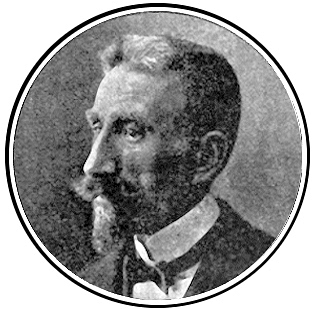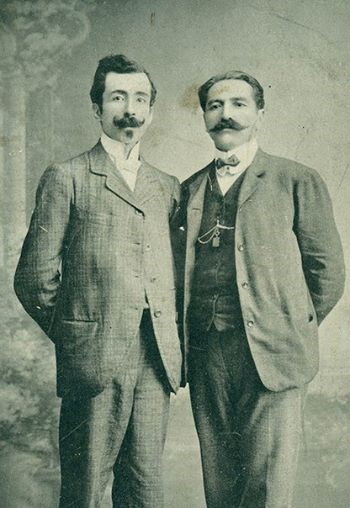|
Harutiun Jangülian
Harutiun Jangülian ( hy, Յարութիւն Ճանկիւլեան; 1855 – 15 June 1915) was an Armenian historian, political activist, and member of the Armenian National Assembly. He was especially known for his involvement in the Kum Kapu demonstration. He spent six years imprisoned in exile. He returned to Constantinople and continued his political activity after his release. Jangülian was arrested on 24 April 1915, at the beginning of the Armenian genocide, deported, and ultimately executed. Early life Harutiun Jangülian was born to an Armenian family in 1855 in Van, within the Ottoman Empire. At the time, Van was considered one of the centers of the Armenian Revolutionary Movement. He joined the Social Democrat Hunchakian Party while in Van and moved to Constantinople in 1884. There Jangülian met leading political activist Hampartsoum Boyadjian of the Hnchak party. The two eventually became the chief organizers of the Kum Kapu demonstration. Kum Kapu demonstration Toward ... [...More Info...] [...Related Items...] OR: [Wikipedia] [Google] [Baidu] |
Kumkapı
Kumkapı (meaning 'sand gate' in Turkish) is a quarter in Fatih district of Istanbul. It is located along the northern shore of Marmara Sea. Up to recent times, Kumkapı is the center of the Armenian community of the city, boasting a school and several churches. It is also where the seat of the Armenian Patriarchate of Constantinople is located. The quarter is famous for its many fish restaurants; therefore attracting many local and foreign tourists round the year. History In the Byzantine period, the area was known in Greek as Kontoskàlion. Transportation Earlier Kumkapı had a station on the suburban railway line Sirkeci- Halkalı but that station was permanently closed when Marmaray opened in 2013. Kumkapı is also easily accessible by sea. See also * Kum Kapu demonstration * List of restaurant districts and streets * Armenians in Turkey * List of Armenian ethnic enclaves This is a list of Armenian ethnic enclaves, containing cities, districts, and neighborh ... [...More Info...] [...Related Items...] OR: [Wikipedia] [Google] [Baidu] |
Sarkis Minassian
Sarkis Minassian (1873 – 1915), also known as Aram Ashod, was an Armenian journalist, writer, political activist, and educator. He became the chief editor of the newspaper '' Hairenik'' in Watertown, Massachusetts. After returning to the Ottoman Empire in 1909, Minassian continued writing in various journals in the city. In 1915, Sarkis Minassian was killed during the Armenian genocide. Life Sarkis Minassian was born in 1873 in the village of Çengiler, near Yalova in northwestern Anatolia. He attained his early education in Bardizag (today Bahçecik, Kocaeli). Thereafter, Minassian moved to Constantinople to continue his education at the Getronagan Armenian High School. After graduating from Getronagan in 1894, Minassian moved to Geneva, Switzerland where he became a staff member of the Armenian newspaper '' Droshak'', the official organ of the Armenian Revolutionary Federation. In 1903, Minassian moved to the United States where he became the managing editor of the Arme ... [...More Info...] [...Related Items...] OR: [Wikipedia] [Google] [Baidu] |
Rupen Zartarian
Rupen Zartarian or Ruben Zardaryan ( hy, Ռուբեն Զարդարյան hyw, Ռուբէն Զարդարեան; 1874 – 16 August 1915) was an Armenian writer, educator, and political activist. He was killed by Ottoman authorities during the Armenian genocide. Life Zartarian was born in 1874 in the city of Diyarbekir, but moved to Harput (or Kharpert) (Armenian: Խարբերդ) when he was two. He received his education from the educational institutions of that city. Zartarian became a student of Tlgadintsi (Hovhannes Harutiunian, 1910–1912), who was a leading figure in rural Armenian literature. Tlgandintsi was also killed by Ottoman authorities during the Armenian Genocide. Zartarian was greatly influenced by his mentor, and his writing career stemmed from the encouragement he obtained. At the age of 18, he started teaching, and for the following decade, he continued in the field of education. At first, he taught at Tlgandinsti's institution, he then spent three years in ... [...More Info...] [...Related Items...] OR: [Wikipedia] [Google] [Baidu] |
Ankara
Ankara ( , ; ), historically known as Ancyra and Angora, is the capital of Turkey. Located in the central part of Anatolia, the city has a population of 5.1 million in its urban center and over 5.7 million in Ankara Province, making it Turkey's second-largest city after Istanbul. Serving as the capital of the ancient Celtic state of Galatia (280–64 BC), and later of the Roman province with the same name (25 BC–7th century), the city is very old, with various Hattian, Hittite, Lydian, Phrygian, Galatian, Greek, Persian, Roman, Byzantine, and Ottoman archeological sites. The Ottomans made the city the capital first of the Anatolia Eyalet (1393 – late 15th century) and then the Angora Vilayet (1867–1922). The historical center of Ankara is a rocky hill rising over the left bank of the Ankara River, a tributary of the Sakarya River. The hill remains crowned by the ruins of Ankara Castle. Although few of its outworks have survived, there are ... [...More Info...] [...Related Items...] OR: [Wikipedia] [Google] [Baidu] |
Ayaş, Ankara
Ayaş is a town and district of Ankara Province in the Central Anatolia region of Turkey, 58 km from the city of Ankara which is very rich for historical monuments. According to 2000 census, population of the district is 21,239 of which 7,839 live in the urban center of Ayaş. The district covers an area of , and the average elevation is . The district is known for its mulberry trees, its tasty tomatoes and its healing mineral water spas, both for drinking and bathing. There is an annual mulberry festival in the town of Ayaş. The town has a long history and is mentioned in folk songs and the journals of the traveller Evliya Çelebi. History The citizens of Ayaş were Oghuz tribes as the village names Bayat, Afşar and Peçenek implies. In 1554, it became a sanjak center, and in 1864 it became a Kaza in Ankara Vilayeti. In Ottoman period, education was advanced in Ayaş. In 1900, there were eight medreses, two primary mekteps and one rüşdiye. Settlements in the d ... [...More Info...] [...Related Items...] OR: [Wikipedia] [Google] [Baidu] |
Deportation Of Armenian Leaders
The deportation of Armenian intellectuals is conventionally held to mark the beginning of the Armenian genocide. Leaders of the Armenian community in the Ottoman capital of Constantinople (now Istanbul), and later other locations, were arrested and moved to two holding centers near Angora (now Ankara). The order to do so was given by Minister of the Interior Talaat Pasha on 24 April 1915. On that night, the first wave of 235 to 270 Armenian intellectuals of Constantinople were arrested. With the adoption of the Tehcir Law on 29 May 1915, these detainees were later relocated within the Ottoman Empire; most of them were ultimately killed. More than 80 such as Vrtanes Papazian, Aram Andonian, and Komitas survived. The event has been described by historians as a decapitation strike, which was intended to deprive the Armenian population of leadership and a chance for resistance. To commemorate the victims of the Armenian genocide, 24 April is observed as Armenian Genocide Remembranc ... [...More Info...] [...Related Items...] OR: [Wikipedia] [Google] [Baidu] |
Young Turk Revolution
The Young Turk Revolution (July 1908) was a constitutionalist revolution in the Ottoman Empire. The Committee of Union and Progress (CUP), an organization of the Young Turks movement, forced Sultan Abdul Hamid II to restore the Ottoman Constitution and recall the parliament, which ushered in multi-party politics within the Empire. From the Young Turk Revolution to the Empire's end marks the Second Constitutional Era of the Ottoman Empire's history. More than three decades earlier, in 1876, constitutional monarchy had been established under Abdul Hamid during a period of time known as the First Constitutional Era, which lasted for only two years before Abdul Hamid suspended it and restored autocratic powers to himself. The revolution began with CUP member Ahmed Niyazi's flight into the Albanian highlands. He was soon joined by İsmail Enver and Eyub Sabri. They networked with local Albanians and utilized their connections within the Salonica based Third Army to instigate a ... [...More Info...] [...Related Items...] OR: [Wikipedia] [Google] [Baidu] |
Cairo
Cairo ( ; ar, القاهرة, al-Qāhirah, ) is the capital of Egypt and its largest city, home to 10 million people. It is also part of the largest urban agglomeration in Africa, the Arab world and the Middle East: The Greater Cairo metropolitan area, with a population of 21.9 million, is the 12th-largest in the world by population. Cairo is associated with ancient Egypt, as the Giza pyramid complex and the ancient cities of Memphis and Heliopolis are located in its geographical area. Located near the Nile Delta, the city first developed as Fustat, a settlement founded after the Muslim conquest of Egypt in 640 next to an existing ancient Roman fortress, Babylon. Under the Fatimid dynasty a new city, ''al-Qāhirah'', was founded nearby in 969. It later superseded Fustat as the main urban centre during the Ayyubid and Mamluk periods (12th–16th centuries). Cairo has long been a centre of the region's political and cultural life, and is titled "the city of a thousand m ... [...More Info...] [...Related Items...] OR: [Wikipedia] [Google] [Baidu] |
Cyprus
Cyprus ; tr, Kıbrıs (), officially the Republic of Cyprus,, , lit: Republic of Cyprus is an island country located south of the Anatolian Peninsula in the eastern Mediterranean Sea. Its continental position is disputed; while it is geographically in Western Asia, its cultural ties and geopolitics are overwhelmingly Southern European. Cyprus is the third-largest and third-most populous island in the Mediterranean. It is located north of Egypt, east of Greece, south of Turkey, and west of Lebanon and Syria. Its capital and largest city is Nicosia. The northeast portion of the island is ''de facto'' governed by the self-declared Turkish Republic of Northern Cyprus, which was established after the 1974 invasion and which is recognised as a country only by Turkey. The earliest known human activity on the island dates to around the 10th millennium BC. Archaeological remains include the well-preserved ruins from the Hellenistic period such as Salamis and Kourion, and Cypr ... [...More Info...] [...Related Items...] OR: [Wikipedia] [Google] [Baidu] |
Palestine (region)
Palestine ( el, Παλαιστίνη, ; la, Palaestina; ar, فلسطين, , , ; he, פלשתינה, ) is a geographic region in Western Asia. It is usually considered to include Israel and the State of Palestine (i.e. West Bank and Gaza Strip), though some definitions also include part of northwestern Jordan. The first written records to attest the name of the region were those of the Twentieth dynasty of Egypt, which used the term "Peleset" in reference to the neighboring people or land. In the 8th century, Assyrian inscriptions refer to the region of "Palashtu" or "Pilistu". In the Hellenistic period, these names were carried over into Greek, appearing in the Histories of Herodotus in the more recognizable form of "Palaistine". The Roman Empire initially used other terms for the region, such as Judaea, but renamed the region Syria Palaestina after the Bar Kokhba revolt. During the Byzantine period, the region was split into the provinces of Palaestina Prima, Palaestin ... [...More Info...] [...Related Items...] OR: [Wikipedia] [Google] [Baidu] |
Acre, Israel
Acre ( ), known locally as Akko ( he, עַכּוֹ, ''ʻAkō'') or Akka ( ar, عكّا, ''ʻAkkā''), is a city in the coastal plain region of the Northern District of Israel. The city occupies an important location, sitting in a natural harbour at the extremity of Haifa Bay on the coast of the Mediterranean's Levantine Sea."Old City of Acre." , World Heritage Center. World Heritage Convention. Web. 15 Apr 2013 Aside from coastal trading, it was also an important waypoint on the region's coastal road and the road cutting inland along the |






